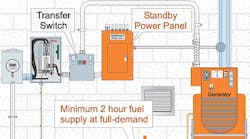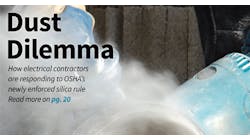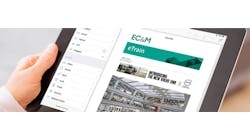Emergency rescue efforts in your facility may depend on how well you meet Art. 701 requirements.
When disaster strikes, not every system needs immediate backup power. While Art. 700 requires essential emergency systems to supply power in 10 sec or less upon loss of power, legally required standby systems (LRSS) that provide power to communications, lighting, and ventilation and smoke-removal systems must supply standby power in 60 sec or less. The systems supported by LRSSs are not critical, but their stoppage could hamper rescue operations or create hazards.
Emergency systems and LRSSs work together to ensure the safety of building occupants in dangerous situations. They have similar Code requirements, but also have distinctive differences. It’s also important to note that although LRSSs fall under the umbrella of emergency systems, they will be referenced as LRSSs in order to distinguish Arts. 700 and 701 in this article.
Testing. It’s crucial that you implement an extensive set of testing procedures for your LRSS. Section 701.5 outlines the following acceptance testing and operational testing requirements set forth by the 2002 NEC:
- Acceptance testing
[701.5(A)]. This is a post-installation set of tests that ensure the LRSSs function according to installation specifications. The AHJ conducts or witnesses acceptance tests of the complete emergency system before the system is put into service.
- Periodic testing
[701.5(B)]. Throughout its life, the system must be tested operationally according to an AHJ-approved schedule to ensure it’s in proper operating condition and remains functional. The AHJ will often use IEEE and NETA standards when evaluating the adequacy of the testing program.
- Battery systems maintenance
[701.5(C)]. Periodic maintenance is a requirement in systems that rely on batteries for starting, control, or ignition in auxiliary engines. IEEE standards and manufacturer recommendations are usually the basis for what the AHJ considers acceptable.
- Testing under load
[701.5(E)]. A load test is the only way to establish with certainty that a system will support the load. Thus, the NEC requires you to have a means for testing all legally required power systems during maximum anticipated load conditions.
- Written records
[701.5(D)]. The owner must keep records of testing and maintenance for each of the preceding tests. Although the Code calls for “written” records, it’s safe to interpret that as “recorded.” Thus a database tool like a CMMS or a testing management program normally satisfies this requirement. If the AHJ wants records that are literally written, you may need to file printed reports. The NEC doesn’t specify the required record retention time period, but if you’re using a database method, then the ability to store such records indefinitely isn’t an issue.
Transfer equipment. Per 701.7, transfer equipment must be automatic. It must prevent the inadvertent interconnection of normal and alternate sources of supply in any operation of the transfer equipment. You can have a means to bypass and isolate the transfer switch equipment, but this isn’t a requirement. Automatic transfer switches must be electrically operated and mechanically held.
In addition, you must provide audible and visual signal devices (701.8) where practicable to indicate when the standby source is malfunctioning or carrying the load, or when the battery charger isn’t functioning.
If your equipment doesn’t meet the requirements of 701.11(F), you must provide signage to satisfy the following informational requirements:
-
A sign at the service entrance equipment indicating type and location of on-site legally required standby power sources.
-
A sign at the grounding location to identify all power sources connected at that location. This is required only when your standby source is connected to a grounding electrode remote from your source.
Circuit wiring. The LRSS wiring can occupy the same raceways, cables, boxes and cabinets with other general wiring. You may wish to separate them, but it is not required by the Code.
Sources of power. If the normal supply fails, emergency power must be available within 60 sec. The supply system for emergency purposes can be any of the following to satisfy this requirement.
- Storage battery
[701.11(A)]. Storage batteries that supply power for LRSSs must be of suitable rating and capacity to supply and maintain the total load for a period of 1.5 hr minimum, without the voltage applied to the load falling below 87.5% of normal. You can get into some sticky liability issues if you fail to consider the actual capacity of your batteries. Factors like the number and depth of hits to the batteries, degree of maintenance, and thermal history have a considerable effect on battery capacity, reducing the actual capacity of the battery over time. So be sure to allow for a reasonable amount of capacity loss rather than assuming the nameplate capacity will be consistent through the life of each cell in the battery.
- Generator set
[701.11(B)]. Here you have several options. Prime mover-driven gen sets need a means for automatically starting the prime mover on failure of the normal service and for automatic transfer and operation of all required electrical circuits, in accordance with 701.7. An internal combustion engine used as prime mover needs an on-site fuel supply with an on-premise fuel supply sufficient for not less than 2 hr full-demand operation of the system (Fig. 1). Fuel storage issues may result in further requirements from the AHJ. Dual fuel supply systems must be able to automatically transfer from one fuel supply to another. Battery power must have a charging means that is independent from the generator. Finally, outdoor gen sets for legally required circuits don’t need an additional disconnecting means on or at the building or structure for the generator feeder conductors if they have readily accessible disconnecting means located within sight of the building or structure supplied (Fig. 2).
If you use a UPS for your LRSS, make sure it complies with the applicable provisions of 701.11(A) and (B).
An additional service installed in accordance with Art. 230, when acceptable to the AHJ, can satisfy the power requirement. To minimize the possibility of simultaneous interruption of emergency supply, the additional service must have the service drop or lateral widely separated electrically and physically from the normal service (Fig. 3).
Where acceptable to the AHJ, you can locate connections located ahead of (but not within) the same cabinet, enclosure or vertical switchboard section as the service disconnecting means.
Individual unit equipment (battery pack) for legally required illumination must include a rechargeable battery, a battery charging means, provisions for one or more lamps mounted on the equipment (it can also have terminals for remote lamps), and a relaying device arranged to energize the lamps automatically upon failure of the supply to the unit equipment.
Unit equipment must be permanently fixed in place, but you can use a flexible cord-and-plug connection if the cord is no longer than 3 ft.
You must put the branch circuit feeding the unit equipment on the same branch circuit as that serving the normal lighting in the area, but connect it ahead of any local switches. At the distribution panel, you must ensure clear identification of the branch circuit that feeds the unit equipment.
Overcurrent protection. The branch-circuit overcurrent protection devices in LRSS circuits must be accessible to authorized persons only and should be identified as such with signage and barriers. Barriers can include room locks and breakaway panel locks. Per (701.17), the alternate source for LRSS doesn’t require ground-fault protection of equipment.
Code compliance is normally thought of as a way to prevent emergencies, but in this case, it primarily helps first responders and other people cope with incidents. LRSSs provide backup power not for your normal operations, but for safety and rescue operations. As a result, they have special requirements beyond those for other kinds of backup power.
When you find yourself stumped by the Code, just e-mail your question to [email protected] or visit www.mikeholt.com. Your question and Mike's answer may be posted in a future Code Q&A column.




